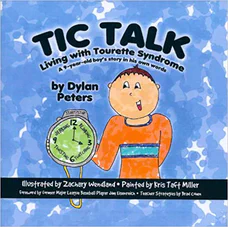Tic Talk: Living with Tourette Syndrome
A 9-year-old boy’s story in his own words
Written by Dylan Peters
Illustrated by Zachary Wendland and Kris Taft Miller
50 pages
•
Published 2007 (Story Monsters press)

Recommended Age Range: 2nd grade through 5th grade.
Publisher's Summary:
In his own words–often humorous, always insightful–Dylan helps readers of all ages understand Tourette Syndrome and the enormous pressures this little understood affliction places on those who have it and on those who love them.

Dr. Annie's Takeaways
Recommended for: This book is great for a child who has recently been diagnosed with Tourette Syndrome and/or who is considering whether and how to share about their diagnosis with friends and classmates. Written by a 9-year-old boy with Tourette Syndrome, it normalizes and validates many experiences common to kids with tics. It provides hope that others will accept them and that Tourette Syndrome will not hold them back from pursuing their dreams (make sure to read the foreword and afterword!).
Tone: Informative, normalizing, hopeful
Story Quality: This book was written by 9-year-old Dylan. It definitely seems like it was written by a kid, with a few lines that perhaps seem edited by parents, but it’s well-written for a book written by a kid! It’s quite long with a lot of words, so it might not hold the attention of some younger children or kids who have trouble sitting through a longer book.
Illustrations: The black-and-white illustrations were drawn in ink by Dylan’s friend Zachary. They’re painted in a slightly strange, blotchy way by an adult illustrator. I wonder if the book was originally published in color; now that the illustrations are in black-and-white, the painting does not add much.
Representation: Dylan is a White 9-year-old boy who was diagnosed with Tourette Syndrome when he was in preschool. His tics include head jerking, long blinking, yawning, gurgling, and clearing his throat. Dylan has a mom, dad, older brother, and younger sister. There is an afterword written by Dylan 14 years after this book was originally published, in which he shares that he “still [has] mild tics, but they’re no longer noticeable to most people, and they haven’t stopped [him] from pursuing [his] dreams.” He graduated from Duke University with a double major in electrical and computer engineering and has a job as a software engineer. The foreword of the book is written by former MLB player Jim Eisenreich about his experience with Tourette Syndrome.
Psychological Practices: This book walks the reader through Dylan’s experience with Tourette Syndrome, from his first experience with tics, through his evaluation with a neurologist and his diagnosis, to treatment with different medications and observations Dylan makes about what makes his tics better or worse (e.g., stress). Dylan initially tries to keep his tics secret from his friends and teachers because he’s afraid that they will reject him for it. He ultimately decides to share about his tics with his class at the start of 3rd grade, and he and his mother give a presentation about Tourette Syndrome to his whole class. Everyone is accepting and nothing changes in the way his friends treat him, but he is much less anxious about having to hide his tics, which actually makes them happen less! The book normalizes and validates a lot of feelings kids have about having tics–feeling frustrated, sad, embarrassed, worried, and it ends on a hopeful note.
Concerns: This book does not mention Habit Reversal Therapy (HRT)
, which is an evidence-based treatment for tics that gives kids and families a behaviorally-based treatment option. This book focuses on reducing stress and finding the right medication as primary treatment avenues, both of which are still also considered first-line treatments for Tourette Syndrome.
